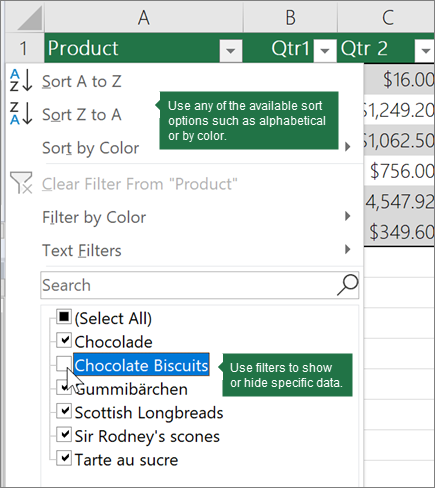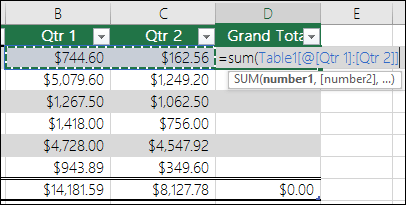
To make managing and analyzing a group of related data easier, you can turn a range of cells into an Excel table (previously known as an Excel list).

Note: Excel tables should not be confused with the data tables that are part of a suite of what-if analysis commands. For more information about data tables, see Calculate multiple results with a data table.
A table can include the following elements:


You can turn off the header row in a table. For more information, see Turn Excel table headers on or off. Banded rows Alternate shading or banding in rows helps to better distinguish the data.

Calculated columns By entering a formula in one cell in a table column, you can create a calculated column in which that formula is instantly applied to all other cells in that table column. For more information, see Use calculated columns in an Excel table.

Total row Once you add a total row to a table, Excel gives you an AutoSum drop-down list to select from functions such as SUM, AVERAGE, and so on. When you select one of these options, the table will automatically convert them to a SUBTOTAL function, which will ignore rows that have been hidden with a filter by default. If you want to include hidden rows in your calculations, you can change the SUBTOTAL function arguments. For more information, also see Total the data in an Excel table.

Sizing handle A sizing handle in the lower-right corner of the table allows you to drag the table to the size that you want.
You can create as many tables as you want in a spreadsheet.
To quickly create a table in Excel, do the following:
Excel has some features that enable you to work efficiently with your table data:
If you have authoring access to a SharePoint site, you can use it to export an Excel table to a SharePoint list. This way other people can view, edit, and update the table data in the SharePoint list. You can create a one-way connection to the SharePoint list so that you can refresh the table data on the worksheet to incorporate changes that are made to the data in the SharePoint list. For more information, see Export an Excel table to SharePoint.
You can always ask an expert in the Excel Tech Community or get support in Communities.